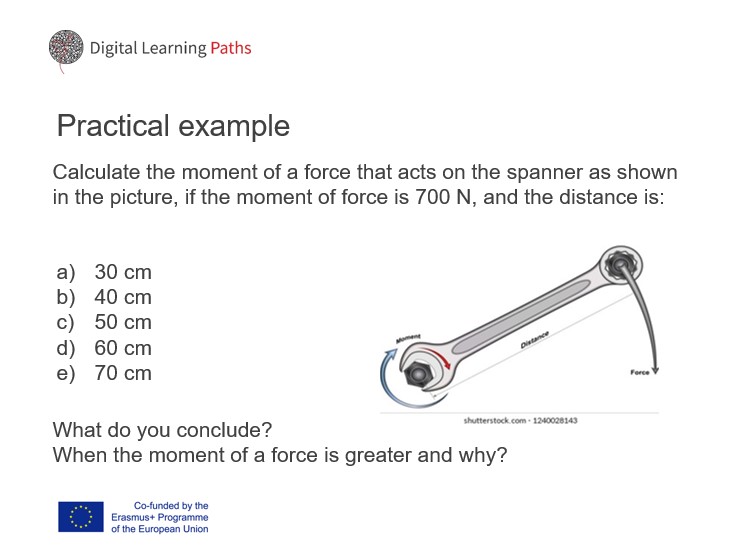Moment of a force
The moment of a force, also known as torque, is a crucial concept in the operation of many machines.
Every day we do lots of activities that are connected to different parts of physics, mechanics, mathematics, and other fields of science. Do you ride a bicycle? You turn pedals during riding a bicycle. Did you know that during turning pedals you are doing moment of a force? How? Just by turning pedals. Can you guess what the moment of a force is? Moment of a force depends on something. Do you know on what? Force, yes, but is that all? Did you try to ride a small and a big bicycle? Which one was easier to ride? Why? The answer is: When you ride a bike, you apply a force to the pedals. The moment of that force creates a torque that rotates the wheels, propelling the bike forward.
Besides riding a bicycle, the moment of a force, also known as torque, is a physical concept that plays a significant role in many everyday activities. Here are a few examples:
1. Using a screwdriver: When you use a screwdriver to tighten or loosen a screw, you apply a force to the handle of the screwdriver. The moment of that force creates a torque that turns the screw, allowing you to either tighten or loosen it.
2. Using a wrench: When you use a wrench to tighten or loosen a bolt, you apply a force to the handle of the wrench. The moment of that force creates a torque that turns the bolt, allowing you to either tighten or loosen it.
3. Playing sports: In many sports, such as baseball, golf, and tennis, players use their bodies to generate a moment of force to hit or throw an object. For example, a baseball pitcher generates a moment of force by rotating their arm around the shoulder joint, which creates a torque that propels the ball forward.
Photo is copied from: Image by Manfred Antranias Zimmer from Pixabay

Read the text and find out why the moment of a force is a crucial concept in the operation of many machines.
The moment of a force, also known as torque, is a crucial concept in the operation of many machines. Here are some examples:
- Engines: In an engine, the moment of force generated by the combustion of fuel creates a torque that turns the crankshaft. The rotation of the crankshaft is then used to power other parts of the machine, such as the wheels in a car or the blades in a fan.
- Electric Motors: Electric motors rely on the principle of electromagnetism to generate a moment of force. The interaction between the magnetic fields of the stator and rotor creates a torque that turns the rotor, allowing the motor to perform work.
- Conveyor Belts: Conveyor belts are used to transport materials in many industries, such as manufacturing and mining. The moment of force generated by a motor is used to rotate the pulley, which in turn moves the belt and transports the materials.
- Cranes: Cranes are used to lift and move heavy objects. The moment of force generated by the crane’s motor is used to rotate the arm, which creates a torque that lifts the load.
- Hydraulic Systems: Hydraulic systems use fluids to transmit force and generate a moment of force. The force applied to the fluid creates a pressure differential that moves a piston, creating a torque that can be used to power other parts of the machine.
In summary, the moment of a force is a critical concept in the operation of many machines, from engines and electric motors to conveyor belts and cranes. Understanding how to generate and control torque is essential to designing and operating efficient and effective machines.
Try to do an experiment. Try to open the door with one finger just as arrows show on the photo. Try to open the door where green arrow is pointing and try to open the door where orange arrow is pointing. Can you open the door where both arrows are pointing? No. Why? Is just a force enough to do the moment of a force? No. What else is crucial to do the moment of a force? Distance from the point is crucial. What is conclusion? As larger the distance is, that smaller the force you need to open the door.

In the presentation it is mathematically explained what moment of a force is.
Watch the video and analyze how moment of force works related to an axis or a point.
Watch the video and find out how law of leverage is working on the moment of a force principle.
Read the text and see how law of leverage and the moment of a force are connected.
The moment of a force and the law of leverage are closely related concepts. The law of leverage states that a small force applied at a distance from a pivot point can produce a larger force at a closer distance, allowing for the movement of a heavy object with less effort.
The moment of a force is a measure of the force’s ability to rotate an object around a pivot point. It is calculated by multiplying the magnitude of the force by the perpendicular distance from the pivot point to the line of action of the force.
In the context of the law of leverage, the moment of a force is used to determine the force required to balance a load. For example, if a lever is used to lift a heavy weight, the moment of the force applied to the lever is equal to the moment of the weight being lifted. By adjusting the distance between the force and the pivot point, the force required to lift the weight can be reduced.
The mechanical advantage of a lever is determined by the ratio of the distance between the pivot point and the load to the distance between the pivot point and the force. The greater the ratio, the greater the mechanical advantage and the easier it is to lift the load.
In summary, the moment of a force is essential to understanding the law of leverage. By using the moment of a force to determine the mechanical advantage of a lever, it is possible to lift heavy loads with less effort.
Answer the questions.
- What is the moment of a force, and how is it calculated?
- How does the moment of a force affect the rotation of an object around a pivot point?
- What is the difference between moment and force, and how are they related?
- How is the moment of a force used in everyday activities?
- How does the moment of a force apply to the operation of machines?
- What is the law of leverage, and how is it related to the moment of a force?
- What factors affect the mechanical advantage of a lever, and how are they related to the moment of a force?
- How does the moment of a force affect the efficiency and effectiveness of machines?
- How can the moment of a force be used to control the movement of objects?
- What are some real-world examples of how the moment of a force is used in engineering and technology?
Write the task and solve it. Answer the questions - When the moment of a force is greater and why?

Resource information